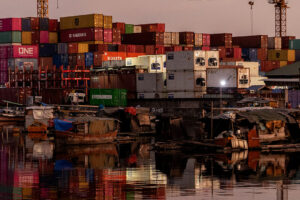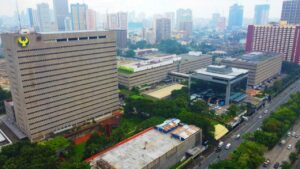
US tariff may trim PHL GDP growth

By Luisa Maria Jacinta C. Jocson, Senior Reporter
THE United States’ 19% tariff on Philippine goods could cut the Philippines’ gross domestic product (GDP) growth by 0.4 percentage point (ppt), Nomura Global Markets Research said.
In a report, Nomura said the US tariff of 19% on Philippine goods is “fairly high” and poses downside risks to growth.
“We estimate the direct effects could reduce our baseline GDP growth forecasts by a still-substantial 0.4 ppt in the Philippines.”
Nomura said this projection is “relatively substantial” compared to its baseline growth forecasts of 5.3% and 5.6% for this year and 2026, respectively.
“This is partly because we assigned 10% as the level where the reciprocal tariff rate could settle, on the assumption that the Philippines is a strong ally of the US and is not a third country for transshipments,” Nomura said.
“As it turns out, despite the visit to Washington by President Marcos and both sides reiterating the need for a strong partnership, the tariff was still set at 19%, which is even higher than the ‘Liberation Day’ level of 17%.”
Last week, Philippine President Ferdinand R. Marcos, Jr. met with US President Donald J. Trump at the White House in Washington, DC.
Mr. Trump announced a 19% tariff would be imposed on Philippine goods, which will take effect starting Aug. 1.
“The trade ‘deals’ therefore represent upside surprises in terms of tariff rates, especially for the Philippines,” Nomura said.
“As a result, if implemented and these tariff rates are sustained, these will likely further weigh on growth in both countries relative to our current baseline forecasts.”
The government expects GDP to grow by 5.5-6.5% this year, lower than its previous target of 6-8%.
“While these ballpark estimates make sense to us, uncertainty remains high and these are ‘only’ taking into account the direct effects on these ASEAN countries’ exports to the US,” Nomura said.
These estimates do not account for sectoral tariffs, such as in semiconductors and pharmaceuticals, which are currently exempted, it added.
“But as our US team highlights, the risk is these could be set higher, though some countries could be exempted, adding to the uncertainty. As mentioned above, the details of the trade deals with Indonesia and the Philippines are still limited.”
“Meanwhile, other major trading partners, particularly the European Union, are still in negotiations and an escalation of trade tensions could pose additional risks for the region,” it added.
The Department of Trade and Industry has said it is still negotiating the final details of the trade agreement with the US to ensure the protection of local industries.
ONE BIG BEAUTIFUL BILLMeanwhile, Mr. Trump’s recent One Big Beautiful Bill Act could also impact the Philippines’ own economy, Metropolitan Bank & Trust Co. (Metrobank) Research said in a separate report.
“While the US faces the direct effects of Mr. Trump’s mega bill, the Philippines will feel the aftershocks. After 2027, the federal funds rate is forecasted to tick up after rate cuts in the short-term.”
Metrobank noted this will have spillover effects on the Bangko Sentral ng Pilipinas’ (BSP) monetary policy and overseas Filipino workers’ (OFW) remittances.
“This can, in turn, push up the BSP’s reverse repurchase rate, hindering domestic consumption. To add, if US GDP growth is dampened by crowding out of private investment, demand for exports and OFW remittances may also take a hit.”
Under the bill, Mr. Trump’s 2017 tax cuts are made permanent and also introduces new tax breaks.
“As the US seeks funding to address the increased expenditure, interest rates are expected to edge higher, perhaps as early as next year. Elevated US rates would in turn attract foreign capital to the US away from emerging market economies like the Philippines,” Metrobank said, adding the BSP could hike rates to “ensure the Philippines remains a competitive choice for investors.”
The Philippine central bank lowered interest rates by a total of 125 basis points (bps) since it began its easing cycle in August last year. It delivered a second straight rate cut in June, reducing borrowing costs by 25 bps to bring the key rate to 5.25%.
Metrobank said higher rates would discourage consumption and business investment, which could potentially slow Philippine growth.
Slowing US growth could also hit the Philippines’ exports sector, as the US is the top destination for Philippine export goods, it said.
“With potentially hampered US economic growth, goods from the Philippines could face a reduction in demand. Fewer exports combined with steeper tariffs can make the trade deficit more drastic and weigh on overall GDP,” it said.
Metrobank said softer US growth may also dampen foreign direct investment in emerging markets like the Philippines.
Meanwhile, OFW remittances may also be dampened as the US starts imposing a 1% excise tax on cash remittance transfers from the US to other countries in 2026.
“The US is a hotspot for OFWs, with approximately 2 million OFWs in the US. OFWs influence the Philippine economy through remittances, which could be negatively impacted by a slowdown in US growth,” Metrobank said.
Around two-fifths of the Philippines’ remittance flows come from the United States. The US was the top source of remittances in the five-month period, accounting for 40.2% of the total, latest central bank data showed.
“If OFWs get pay cuts or even lose their jobs, this would cap remittances headed for home. Remittance payments spur household spending, which contributes 78.2% of the Philippines’ GDP.”
The BSP earlier estimated that the remittance tax could trim the country’s remittance growth by 0.5 ppt. The central bank expects cash remittances to grow by 2.8% this year and by 3% in 2026.
“A decline in remittances pulls down household expenditure, rocking the boat for growth,” Metrobank added.



